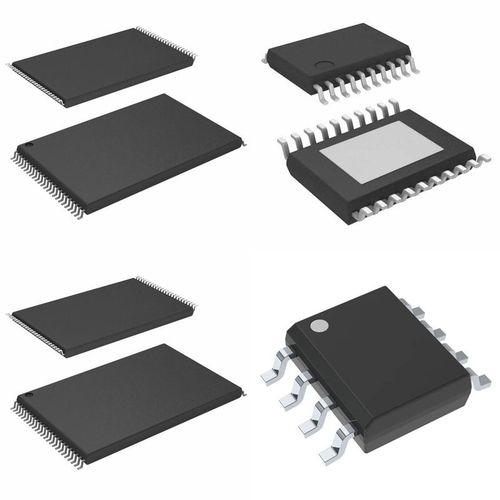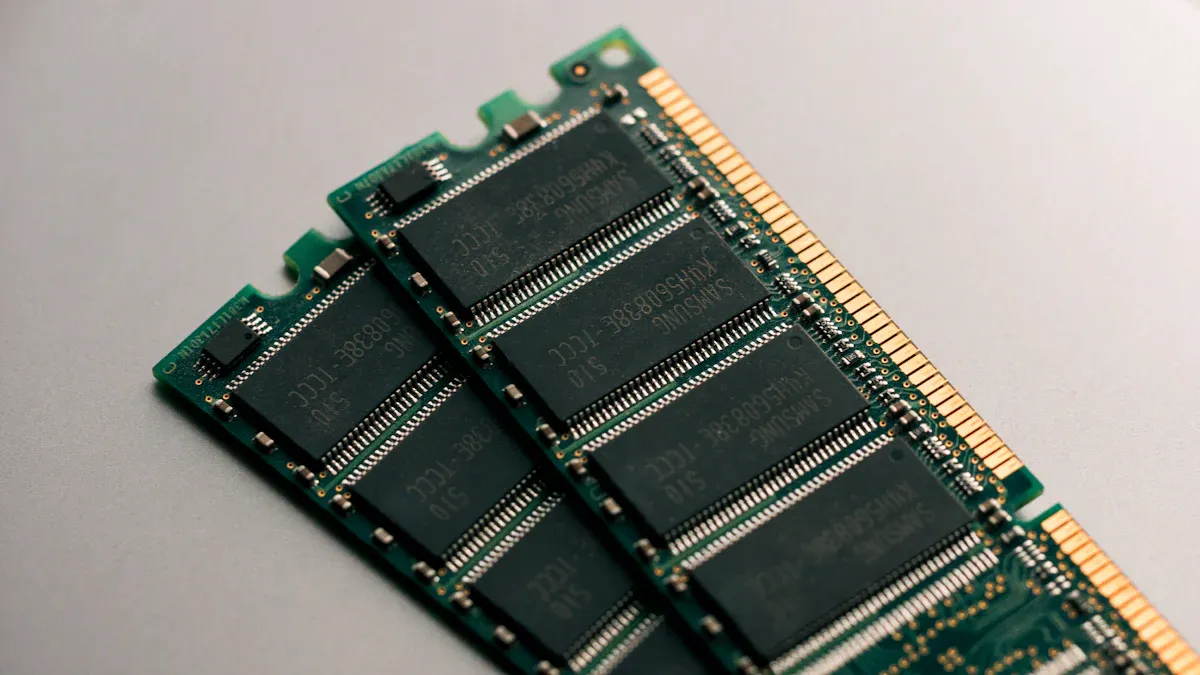S34ML08G101TFA and S34ML08G101TFI specs made simple

8 Gbit SLC NAND Flash memory
Parallel ONFI-compliant interface
48-pin TSOP package
Operating voltage: 2.7–3.6 V
Endurance features: ECC, wear-leveling, bad block management
S34ML08G101TFA: –40 °C to +125 °C (automotive)
S34ML08G101TFI: –40 °C to +85 °C (industrial)
S34ML08G101TFA and S34ML08G101TFI serve as robust non-volatile storage chips. Engineers use these chips in automotive control units, industrial automation, and high-reliability embedded systems. The main difference comes from their temperature ranges. S34ML08G101TFA works best in automotive environments, while S34ML08G101TFI fits industrial settings.
Key Takeaways
Both chips offer 8 Gbit SLC NAND Flash memory with strong reliability features like error correction and wear-leveling.
The main difference is temperature range: TFA works from –40°C to +125°C for automotive use, TFI works from –40°C to +85°C for industrial use.
Choose TFA for harsh environments like cars and outdoor equipment; choose TFI for industrial and indoor applications.
Both chips use a fast, parallel ONFI-compliant interface and operate at 2.7 to 3.6 volts for easy integration.
Always match the chip’s temperature range to your device’s environment to ensure reliable and long-lasting performance.
S34ML08G101TFA and S34ML08G101TFI Overview

Main Features
S34ML08G101TFA and S34ML08G101TFI offer several important features for embedded system designers. Both chips use single-level cell (SLC) NAND Flash technology, which provides high reliability and endurance. Each chip stores 8 Gbit of data, organized as 1 G × 8. The parallel ONFI-compliant interface allows for fast data transfer and easy integration with many controllers.
Key features include:
8 Gbit SLC NAND Flash memory
Parallel ONFI-compliant interface for compatibility
48-pin TSOP package for standard mounting
Operating voltage range from 2.7 V to 3.6 V
Built-in error correction code (ECC) support
Wear-leveling and bad block management for longer lifespan
Note: SLC NAND Flash technology helps maintain data integrity, even in harsh environments.
Applications
Engineers use these memory chips in a wide range of products that require reliable non-volatile storage. S34ML08G101TFA and S34ML08G101TFI appear in automotive control units, where they store critical data for engine management and infotainment systems. Industrial automation systems, such as programmable logic controllers (PLCs), also rely on these chips for robust performance.
Other common applications include:
Networking and storage appliances
Consumer electronics that need durable flash memory
Medical devices requiring high reliability
Embedded systems in outdoor or high-temperature environments
These chips support products that must operate in challenging conditions. Designers select the appropriate version based on the required temperature range and application needs.
Comparison Table
Specs at a Glance
When engineers compare S34ML08G101TFA and S34ML08G101TFI, they see that both chips offer similar core features. Each chip uses 8 Gbit SLC NAND Flash memory. Both support a parallel ONFI-compliant interface and come in a 48-pin TSOP package. The operating voltage for both chips ranges from 2.7 V to 3.6 V. Each chip includes advanced reliability features, such as error correction code (ECC), wear-leveling, and bad block management.
The main difference between these two chips lies in the temperature range. S34ML08G101TFA supports a wider temperature range, making it suitable for automotive environments. S34ML08G101TFI fits industrial applications with a slightly narrower range.
Tip: Always check the temperature requirements of your application before choosing between these two chips.
Below is a side-by-side comparison table for quick reference:
Feature | S34ML08G101TFI | S34ML08G101TFA |
|---|---|---|
Capacity | 8 Gbit (1 G × 8) | 8 Gbit (1 G × 8) |
Interface | Parallel ONFI-compliant | Parallel ONFI-compliant |
Package | 48-pin TSOP | 48-pin TSOP |
Operating Voltage | 2.7 V – 3.6 V | 2.7 V – 3.6 V |
Temperature Range | –40 °C to +85 °C (Industrial) | –40 °C to +125 °C (Automotive) |
Reliability Features | ECC, wear-leveling, bad block management | ECC, wear-leveling, bad block management |
S34ML08G101TFA and S34ML08G101TFI both deliver robust performance and high reliability. The temperature range stands out as the key factor for selecting the right chip for a specific environment.
Detailed Specs
Memory Organization
S34ML08G101TFA and S34ML08G101TFI both use a single-level cell (SLC) NAND Flash structure. Each chip stores 8 gigabits of data, organized as 1 gigabit by 8 bits. This means the memory divides into eight data lines, which allows for fast parallel data access. The chips use a page-based architecture. Each page holds a set amount of data, and several pages form a block. This structure helps with efficient data management and supports high-speed read and write operations.
Note: SLC NAND Flash stores one bit per cell, which increases reliability and endurance compared to multi-level cell designs.
Performance and Voltage
Both chips operate within a voltage range of 2.7 to 3.6 volts. This range supports compatibility with many embedded systems and controllers. The typical page program time is about 25 microseconds, which allows for quick data writing. Block erase times also remain short, supporting fast memory management. The parallel ONFI-compliant interface ensures high data transfer rates and smooth integration with standard controllers.
Operating voltage: 2.7 V to 3.6 V
Page program time: ~25 µs
Fast block erase and read speeds
Reliability Features
Engineers rely on these chips for their strong reliability features. Both models include built-in error correction code (ECC), which detects and corrects data errors. Wear-leveling technology spreads out write and erase cycles, which extends the chip’s lifespan. Bad block management identifies and isolates faulty memory blocks, keeping data safe and accessible.
Reliability Feature | Description |
|---|---|
ECC | Detects and corrects errors automatically |
Wear-leveling | Distributes usage evenly for longer life |
Bad block management | Isolates faulty blocks to protect stored data |
These features make S34ML08G101TFA and S34ML08G101TFI suitable for demanding environments where data integrity matters most.
Key Differences
Temperature Range
Temperature range stands as the most important difference between S34ML08G101TFA and S34ML08G101TFI. The S34ML08G101TFA chip supports a wide temperature range from –40 °C to +125 °C. This range meets the demands of automotive environments, where electronics often face extreme heat or cold. In contrast, S34ML08G101TFI operates from –40 °C to +85 °C. This range fits most industrial and commercial settings, where temperatures rarely reach the highest extremes found in vehicles or outdoor equipment.
Tip: Always check the maximum and minimum temperatures your device will face before choosing a memory chip.
The table below highlights the temperature grades:
Model | Temperature Range | Typical Application |
|---|---|---|
S34ML08G101TFA | –40 °C to +125 °C | Automotive, harsh outdoor |
S34ML08G101TFI | –40 °C to +85 °C | Industrial, indoor |
Automotive-grade chips like S34ML08G101TFA must handle higher temperatures because car engines, dashboards, and outdoor systems can get very hot or cold. Industrial-grade chips such as S34ML08G101TFI work well in factories, control rooms, and most consumer electronics.
Use Case Selection
Selecting the right chip depends on the environment where the device will operate. Engineers should match the chip’s temperature range to the real-world conditions of their application.
Choose S34ML08G101TFA for:
Automotive control units
Outdoor equipment exposed to sunlight or freezing weather
Aerospace or transportation systems with extreme temperature swings
Choose S34ML08G101TFI for:
Industrial automation and PLCs
Networking and storage appliances in climate-controlled spaces
Medical devices and consumer electronics used indoors
Note: Using a chip outside its rated temperature range can lead to data loss or device failure.
S34ML08G101TFA and S34ML08G101TFI both offer strong reliability and endurance. The main factor in choosing between them is the temperature range required by the application. By understanding the environment, engineers can select the best chip for long-lasting and safe operation.
S34ML08G101TFA and S34ML08G101TFI in Real Applications
Automotive and Industrial
Automotive systems demand memory that can handle extreme temperatures and constant vibrations. Engineers often select the TFA version for these environments. This chip works well in engine control units, infotainment systems, and advanced driver-assistance modules. Vehicles experience rapid temperature changes, so the wide temperature range of the TFA model ensures reliable operation.
Industrial automation also relies on robust memory. Programmable logic controllers (PLCs) and factory robots use these chips to store critical instructions and logs. The TFI version fits most industrial settings, where temperatures stay within a moderate range. Both versions support fast data access, which helps machines respond quickly to commands.
Tip: In both automotive and industrial fields, reliability and endurance matter most. These chips offer built-in error correction and wear-leveling, which help prevent data loss during long-term use.
Consumer and Embedded
Consumer electronics need dependable storage for smooth performance. Devices like smart TVs, set-top boxes, and home networking equipment use these memory chips to store firmware and user data. The TFI version often appears in these products because most homes and offices maintain stable temperatures.
Embedded systems designers value flexibility and reliability. Medical devices, handheld scanners, and outdoor monitoring stations benefit from these chips. For outdoor or mobile devices that face harsh weather, the TFA version provides extra protection against temperature extremes.
Common embedded uses:
Medical monitoring equipment
Security cameras
Remote sensors
These applications show how the right memory chip supports safe, efficient, and long-lasting device operation.
Both chips deliver 8 Gbit SLC NAND Flash memory, a parallel ONFI-compliant interface, and strong reliability features. The main difference comes from the temperature range. S34ML08G101TFA works best in automotive or outdoor environments with extreme temperatures. S34ML08G101TFI fits industrial and indoor uses.
For quick decisions, check the comparison table and match your application’s temperature needs to the right chip.
What is the main difference between S34ML08G101TFA and S34ML08G101TFI?
The main difference is the temperature range. S34ML08G101TFA supports –40 °C to +125 °C for automotive use. S34ML08G101TFI supports –40 °C to +85 °C for industrial use.
Can both chips work in consumer electronics?
Yes, both chips can work in consumer electronics. S34ML08G101TFI fits most indoor devices. S34ML08G101TFA suits products that face extreme temperatures, such as outdoor or automotive electronics.
What reliability features do these chips offer?
Both chips include error correction code (ECC), wear-leveling, and bad block management. These features help protect data and extend the chip’s lifespan.
Are S34ML08G101TFA and S34ML08G101TFI still available?
Distributors like DigiKey and Octopart still offer these chips. They are considered obsolete, so availability may be limited.
How do engineers choose the right chip for their project?
Engineers check the device’s temperature range first. They select S34ML08G101TFA for harsh or automotive environments. They choose S34ML08G101TFI for industrial or indoor settings.
See Also
A Detailed Look At MC9S12DJ256MFUE For Vehicles
Highlighting The Best Features Of SPC5605BMLL6 And SPC5607BMLL6
Unveiling The Important Specs Of MC9S12XEQ512CAL
Key Automotive Capabilities Of FREESCALE MCF5251CVM140 Explained
CALL US DIRECTLY
(+86)755-82724686
RM2508,BlockA,JiaheHuaqiangBuilding,ShenNanMiddleRd,Futian District,Shenzhen,518031,CN
www.keepboomingtech.com sales@keepboomingtech.com
